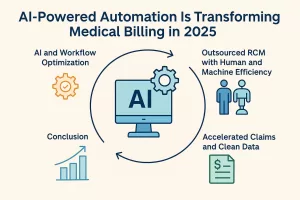Effective medical revenue cycle management is crucial for any healthcare organization looking to enhance its financial performance. This blog will offer you practical tips to streamline your processes, minimize billing errors, and ensure faster payments. Let’s dive into some actionable strategies that can help you elevate your medical revenue cycle management efficiency.
1. Streamline Your Billing Processes
Simplifying and automating billing can drastically reduce errors and improve efficiency. By integrating automated systems, your team can eliminate repetitive manual tasks that often lead to mistakes. Not only does automation help speed up the billing cycle, but it can also free up your staff to focus on more complex queries that require a human touch. In this digital age, relying on outdated processes can hinder your revenue flow, and taking the time to implement tech-savvy solutions will pay dividends.
Consider adopting electronic billing systems that allow for seamless submission of claims and real-time tracking of payment statuses. This transparency helps your staff quickly follow up on unresolved claims, minimizing delays. Additionally, create a standardized protocol for handling billing inquiries, ensuring that each team member knows how to assist patients effectively while providing them with clear information about their financial responsibilities.
2. Invest in Quality Training for Staff
Regular training ensures that your team is up-to-date on compliance regulations and best practices. Understanding the nuances of medical revenue cycle management is vital, as regulations are continuously evolving. Whether through workshops, online courses, or industry conferences, investing in your employees’ knowledge not only enhances their skills but also boosts their confidence, leading to improved performance on the job.
Furthermore, incorporating cross-training programs can empower employees to handle multiple roles within the revenue cycle, creating a more versatile and efficient team. This approach not only prepares your organization for unforeseen staffing issues but also encourages collaboration and knowledge sharing, ultimately strengthening the entire billing process.
3. Utilize Advanced Technology Solutions
Incorporate revenue cycle management software that can automate tasks and provide insightful analytics. The right technology doesn’t just streamline operations; it offers valuable insights into your revenue cycle efficiency. By implementing software that tracks key metrics, you can identify trends over time—allowing your team to pinpoint areas that require immediate attention.
Moreover, features like predictive analytics can forecast cash flow based on historical data, helping your organization remain proactive rather than reactive. As healthcare grows increasingly complex, having robust technology solutions becomes not just a luxury, but a necessity for achieving and maintaining financial health.
4. Implement Clear Communication Channels
Establishing direct lines of communication can help resolve patient inquiries quickly and efficiently. In the realm of medical revenue cycle management, clarity in communication is paramount. Patients often have questions regarding their bills, insurance coverage, or payment options, and a dedicated communication strategy can streamline responses.
Consider using a combination of phone, email, and secure patient portals to ensure that all inquiries are addressed promptly. Encourage your staff to be approachable and open to questions, which fosters a positive patient experience and can lead to timely payments. Remember, when patients feel informed and valued, they are more likely to engage positively with your financial processes.
5. Enhance Patient Engagement Strategies
Educating patients about their bills and payment plans can reduce confusion and improve collections. It’s essential to present billing information in a way that is straightforward and accessible. Use simple language and clear visual formats to break down complex charges, which can demystify the billing process.
Additionally, offering personalized payment plans or discounts for early settlement can be an effective strategy to enhance patient engagement. When patients understand their financial responsibilities and have convenient options available, they are more likely to pay their bills promptly, leading to improved cash flow for your organization.
6. Conduct Regular Audits of Your Processes
Routine audits help identify inefficiencies and areas for improvement in your revenue cycle. By taking a step back to analyze your current systems, you can uncover hidden issues that may be costing your organization time and money. Set a schedule for regular audits to track compliance, billing accuracy, and denial rates.
During these audits, involve multiple departments to provide a comprehensive perspective of your revenue cycle. The more eyes you have on the process, the easier it will be to spot discrepancies and address them quickly. This collaborative approach not only enhances accountability but fosters a shared commitment to continuous improvement.
7. Focus on Denial Management
Analyzing and addressing patterns in claim denials can significantly improve your revenue. Claim denials can quickly accumulate and become a significant obstacle for your revenue cycle. By employing a systematic approach to denial management, you can isolate common reasons for denials and proactively resolve these issues.
Create a dedicated team focused on tracking trends and tackling denials as they arise. This team can help develop tailored strategies for frequent denial reasons, ensuring your organization gets reimbursed efficiently. A robust denial management system not only enhances cash flow but also increases the overall accuracy of your revenue cycle.
8. Adopt an Effective Collections Strategy
A structured approach to collections can optimize payment turnaround times. It’s essential to define specific procedures not just for following up overdue accounts, but also for communicating with patients about their balances. A well-structured collections strategy includes timely reminders and clear pathways for patients to make payments.
Integrating technology can further enhance this process, allowing for automated reminders that feel personal and timely. However, it’s crucial to strike a balance; while staying persistent on collections, a compassionate approach can encourage patients to resolve their balances without feeling pressured.
9. Keep Up with Regulatory Changes
Staying informed about changes in healthcare policies can help you maintain compliance and avoid penalties. The regulatory landscape is constantly shifting, making it essential for your team to have access to the latest updates. Subscribe to industry newsletters, participate in webinars, and make it a priority to regularly review regulations pertinent to medical revenue cycle management.
Consider appointing a compliance officer responsible for tracking these changes and disseminating information throughout your organization. This proactive approach will ensure your processes are not only up to date but also that your staff are well-prepared to adapt to any new guidelines.
10. Engage with Payers Regularly
Maintaining a good relationship with payers can facilitate smoother claims processing. Paying attention to payer dynamics and communicating regularly can make a vast difference in how effectively claims are handled. Schedule periodic meetings with payer representatives to discuss trends, address concerns, and build rapport.
Strong alliances with payers help mitigate issues before they escalate, providing your organization with a platform to resolve disputes and understand evolving payer requirements. These relationships can also lead to reduced denial rates and faster payments, ultimately benefiting your bottom line.
11. Standardize Your Charge Capture Processes
Ensuring consistent charge capture practices minimizes revenue leakage. A standardized process means that all services provided are accurately documented and billed accordingly, leaving less room for error. Creating detailed charge capture training programs for clinical staff can encourage compliance and accountability within your organization.
Utilizing technology that integrates with your electronic health records (EHR) can streamline this process even further. The moment a service is performed, it can be recorded and queued for billing. This integration not only helps you capture every charge but also supports your team in maintaining consistency across all departments.
12. Leverage Data Analytics
Utilizing data analytics can provide insights that drive better decision-making in your revenue cycle. Data is a powerful tool, and harnessing it allows you to make informed choices that can optimize performance. Start by identifying key metrics that are critical to your revenue cycle and regularly analyze this data to spot trends.
From patient demographics to payment patterns, the insights you gain can guide your strategy. For instance, if your analytics reveal a particular service with a high denial rate, you can focus efforts on addressing those specific challenges. Being data-driven is not merely a trend; it’s an essential strategy for thriving in today’s healthcare environment.
13. Create a Patient-Friendly Billing Experience
User-friendly bills and payment options can lead to a higher rate of patient payments. When patients receive clear, comprehensible bills that outline their charges, they are less likely to have questions or issues that delay payment. Simplifying the layout of your bills and highlighting key information can significantly enhance the patient experience.
Additionally, consider offering various payment options, whether it’s credit card payments, ACH transfers, or payment plans. By providing flexibility, you not only cater to the diverse financial situations of your patients but also create an environment that encourages prompt payments.
14. Monitor Key Performance Indicators
Tracking KPIs allows you to assess the health of your revenue cycle and make informed adjustments. Essential metrics such as days in accounts receivable, denial rates, and net collection rates are critical indicators of performance. Setting benchmarks for these KPIs can help you monitor progress and identify potential areas for improvement.
Moreover, holding regular meetings to review these metrics with your team can help cultivate a culture of accountability. Open discussions about performance can encourage staff to take ownership of their roles and recognize where they can contribute to enhancing efficiency.
15. Foster a Culture of Accountability
Encouraging ownership among staff for the billing process can enhance overall efficiency. When every team member understands their impact on the revenue cycle, it motivates them to contribute positively. Establishing clear roles and responsibilities coupled with a support system can facilitate this culture of accountability.
Celebrate small victories and recognize staff efforts towards improving processes. This not only boosts morale but also reinforces the importance of each team member’s role in achieving organizational goals. Empowering your team to take initiative will often lead to creative solutions that enhance medical revenue cycle management.
16. Utilize Pre-Authorization Effectively
Implementing pre-authorization can prevent payment delays due to lack of approvals. This crucial step ensures that the services provided are deemed medically necessary before they are rendered, thus safeguarding your cash flow. Ensuring that your staff is equipped with adequate resources and training surrounding pre-authorization requirements will optimize this process.
Develop a checklist for pre-authorization requirements per service and ensure it’s readily accessible to all relevant team members. By streamlining this aspect of your revenue cycle management, you reduce the risk of denials and create a more efficient pathway for reimbursement.
17. Improve Documentation Practices
Accurate documentation is essential for justifying claims and ensuring proper reimbursement. Training staff on the importance of thorough and precise documentation cannot be overstated. Establishing standardized templates and protocols for documenting services ensures consistency across your organization.
Furthermore, regularly reviewing documentation practices can identify improvement opportunities, ensuring that any gaps or errors are addressed swiftly. This proactive approach not only enhances billing accuracy but strengthens your overall revenue cycle management.
18. Offer Flexible Payment Options
Providing patients with multiple payment options can increase collection rates and patient satisfaction. In today’s fast-paced world, flexibility is key. Whether it’s through online payment portals, mobile apps, or traditional methods, ensuring that patients can access convenient payment solutions can encourage timely payments.
Additionally, consider offering potential discounts for upfront payments or establishing manageable installment plans for those who require them. By catering to the financial needs of your patients, you not only enhance your collections but also foster better relationships with your community.
19. Develop a Robust Follow-Up Process
A thorough follow-up procedure on outstanding bills can greatly improve collections. It’s essential to have a dedicated team or designate individuals responsible for following up on unpaid invoices. Ensure that follow-up processes are timely and systematic—typically on a schedule that begins soon after the payment due date.
Utilizing automated tools can help manage follow-ups efficiently, sending reminders that feel personal while also being consistent. It’s important that this process is viewed not just as a collections tactic but as a means to support patients in fulfilling their financial obligations.
20. Encourage Continuous Improvement
Fostering an environment that embraces change and innovation can lead to long-term efficiency. Encourage your team to be open to new ideas and improvements within your processes. Regular brainstorming sessions can act as a platform for sharing best practices and exploring creative solutions to existing challenges.
Consider establishing a suggestion box or a feedback system where staff can propose improvements actively. When employees see their ideas being recognized and implemented, it not only boosts morale but creates a culture geared toward continuous growth, ultimately benefiting your medical revenue cycle management strategy.




